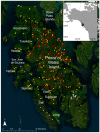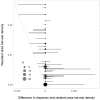Patterns of Wolf Dispersal Respond to Harvest Density across an Island Complex
- PMID: 38396590
- PMCID: PMC10885989
- DOI: 10.3390/ani14040622
Patterns of Wolf Dispersal Respond to Harvest Density across an Island Complex
Abstract
Wolves are highly mobile predators and can disperse across a variety of habitats and over long distances. However, less is known about dispersal capabilities across water and among islands. The biogeography of island systems fosters spatially structured local populations, and their degree of connectivity may influence the dynamics and long-term viability of the regional population. We sought to quantify wolf dispersal rate, distance, and dispersal sex bias throughout Prince of Wales Island, a 6670 km2 island in southeast Alaska, and the surrounding islands that constitute the wildlife management unit (9025 km2). We also investigated patterns of dispersal in relation to hunting and trapping intensity and wolf population density. We used DNA data collected during 2012-2021 long-term monitoring efforts and genotyped 811 wolves, 144 of which (18%) were dispersers. Annual dispersal rates were 9-23% and had a weakly positive relationship with wolf density. Wolves dispersed 41.9 km on average (SD = 23.7 km), and males and females did not disperse at different rates. Of the dispersing wolves, 107 died, and the majority (n = 81) died before they were able to settle. The leading manner of death was trapping (97% of mortalities), and wolves tended to disperse from areas with low harvest density to areas where harvest density was relatively higher. Dispersal occurred both to and from small islands and the larger Prince of Wales Island, indicating bidirectional as opposed to asymmetrical movement, and the genetic overlap of wolf groups demonstrates connectivity throughout this naturally patchy system. Island ecosystems have different predator-prey dynamics and recolonization processes than large, intact systems due to their isolation and restricted sizes; thus, a better understanding of the degree of population connectivity including dispersal patterns among islands in the Prince of Wales archipelago could help inform the management and research strategies of these wolves.
Keywords: Canis lupus; dispersal; islands; noninvasive genetic monitoring.
Conflict of interest statement
The authors declare no conflicts of interest.
Figures




Similar articles
-
Wolves Recolonizing Islands: Genetic Consequences and Implications for Conservation and Management.PLoS One. 2016 Jul 6;11(7):e0158911. doi: 10.1371/journal.pone.0158911. eCollection 2016. PLoS One. 2016. PMID: 27384049 Free PMC article.
-
Assessment of anadromous salmon resources in the diet of the Alexander Archipelago wolf using stable isotope analysis.Oecologia. 1999 Aug;120(3):327-335. doi: 10.1007/s004420050866. Oecologia. 1999. PMID: 28308010
-
Response of moose hunters to predation following wolf return in Sweden.PLoS One. 2015 Apr 8;10(4):e0119957. doi: 10.1371/journal.pone.0119957. eCollection 2015. PLoS One. 2015. PMID: 25853570 Free PMC article.
-
Patterns and determinants of dispersal in grey wolves (Canis lupus).Biol Rev Camb Philos Soc. 2022 Apr;97(2):466-480. doi: 10.1111/brv.12807. Epub 2021 Oct 18. Biol Rev Camb Philos Soc. 2022. PMID: 34664396 Review.
-
No place like home? A test of the natal habitat-biased dispersal hypothesis in Scandinavian wolves.R Soc Open Sci. 2018 Dec 12;5(12):181379. doi: 10.1098/rsos.181379. eCollection 2018 Dec. R Soc Open Sci. 2018. PMID: 30662744 Free PMC article.
Cited by
-
Genomic Analysis Reveals Inbreeding in an Island Population of Alexander Archipelago Wolves.Evol Appl. 2025 Aug 12;18(8):e70144. doi: 10.1111/eva.70144. eCollection 2025 Aug. Evol Appl. 2025. PMID: 40800676 Free PMC article.
References
-
- Hanski I. Metapopulation Dynamics: From Concepts and Observations to Predictive Models. In: Hanski I.A., Gilpin M.E., editors. Metapopulation Biology: Ecology, Genetics, and Evolution. Academic Press; San Diego, CA, USA: 1997. pp. 69–91.
-
- MacArthur R.H., Wilson E.O. The Theory of Island Biogeography. Princeton University Press; Princeton, NJ, USA: 1967. pp. 1–203.
-
- Holt R.D. Towards a Trophic Island Biogeography: Reflections on the Interface of Island Biogeography and Food Web Ecology. In: Losos J.B., Ricklefs R.E., editors. The Theory of Island Biogeography Revisited. Princeton University Press; Princeton, NJ, USA: 2010. pp. 143–185.
-
- Murray D.L., Smith D.W., Bangs E.E., Mack C., Oakleaf J.K., Fontaine J., Boyd D., Jiminez M., Niemeyer C., Meier T.J., et al. Death from Anthropogenic Causes Is Partially Compensatory in Recovering Wolf Populations. Biol. Conserv. 2010;143:2514–2524. doi: 10.1016/j.biocon.2010.06.018. - DOI
-
- Person D.K., Russell A.L. Correlates of Mortality in an Exploited Wolf Population. J. Wildl. Manag. 2008;72:1540–1549. doi: 10.2193/2007-520. - DOI
Grants and funding
LinkOut - more resources
Full Text Sources

